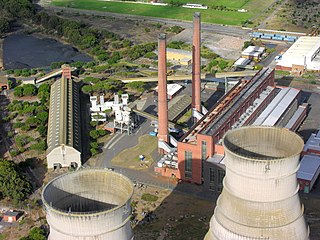The following page lists biggest power stations in Lithuania .

| Name | Town | Coordinates | Type | Capacity | Years | Notes |
|---|---|---|---|---|---|---|
| Achema Power Plant | Jonava | Fossil fuel | 75 MW | 2006-present | Serves Achema factory | |
| Ignalina Nuclear Power Plant | Visaginas | 55°36′20″N26°33′45″E / 55.6055297°N 26.5624094°E | Nuclear | 3000 MW | 1984–2009 | Two RBMK reactors. Decommissioned in 2009. |
| Elektrėnai Power Plant | Elektrėnai | 54°46′11″N24°38′52″E / 54.7697761°N 24.647913°E | Fossil fuel | 1800 MW +435 MW | 1962–present | Cooled by the Elektrėnai Reservoir |
| Klaipėda Combined Heat and Power Plant | Klaipėda | Biomass | 20 MW | 2013–present | Supplies 50 MW heat power | |
| Klaipėda Geothermal Demonstration Plant | Klaipėda | 55°41′04″N21°12′06″E / 55.6844741°N 21.2017894°E | Geothermal | 35 MW | 2004–2017 | |
| Kaunas Hydroelectric Power Plant | Kaunas | 54°52′26″N23°59′58″E / 54.8739893°N 23.9994836°E | Hydroelectric | 100 MW | 1960–present | Created Kaunas Reservoir |
| Kruonis Pumped Storage Plant | Kruonis | 54°47′57″N24°14′50″E / 54.7990769°N 24.2470837°E | Hydroelectric | 900 MW | 1992–present | 4 units, 225 MW each |
| Lifosa Power Plant | Kėdainiai | 37 MW | Serves Lifosa factory | |||
| Panevėžys Combined Heat and Power Plant | Panevėžys | Fossil fuel | 35 MW | 2008–present | ||
| Šiauliai Biomass Power Plant | Šiauliai | Biomass | 11 MW | 2012–present | Provides 27 MW heat power to Šiauliai | |
| Vilnius Combined Heat and Power Plant | Vilnius | 54°40′04″N25°09′21″E / 54.6677508°N 25.1558805°E | Fossil fuel | 384 MW | 1951–present | |
| Vilnius Heat Plant | Vilnius | Fossil fuel | 12 MW | 1951–present | 913 MW heating power | |
| Vilnius Power Plant | Vilnius | Fossil fuel | 1903–1998 | The first power station in Lithuania. No longer active. | ||
| Kaunas Combined Heat and Power Plant | Kaunas | 54°55′16″N24°01′08″E / 54.9211614°N 24.0188169°E | Fossil fuel | 170 MW | 1975–present | |
| Mažeikiai Combined Heat and Power Plant | Mažeikiai | 56°23′03″N22°11′03″E / 56.38425°N 22.1841002°E | Fossil fuel | 160 MW | 1979–present | Serves oil refinery ORLEN Lietuva |
| Others | Fossil - 31 MW, Hydro - 130 MW, Wind - 1284 MW, Solar 1297 MW, Biomass - 221 MW [1] |



